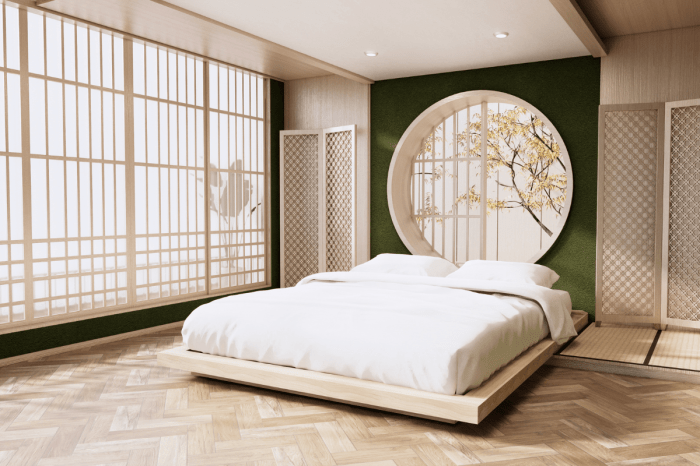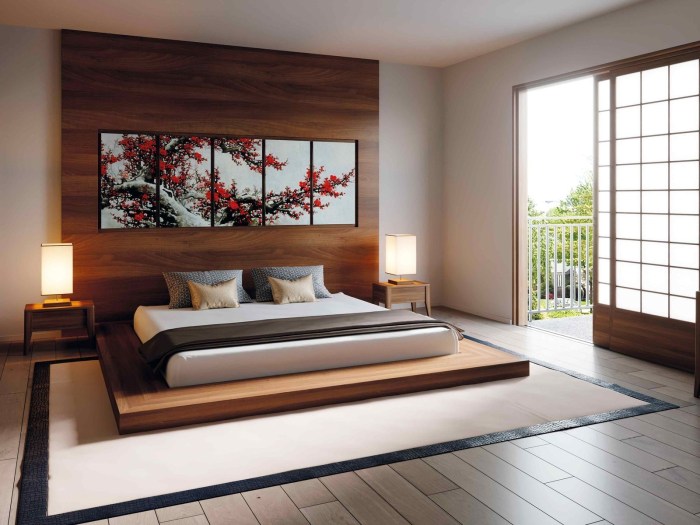How to Decorate a Japanese Room Creating Serenity and Elegance

Tips for Creating a Serene Japanese Room
How to decorate a japanese room – When it comes to decorating a Japanese room, simplicity and minimalism are key. Start by decluttering the space and only keeping items that serve a purpose or bring you joy. Opt for natural materials such as wood and bamboo to create a calming atmosphere.
What Do You Mean by Japanese Room Decor?

Japanese room decor is characterized by clean lines, neutral colors, and a focus on nature. It often incorporates elements such as tatami mats, sliding doors, and paper lanterns to create a sense of tranquility and harmony.
What is Known About Japanese Interior Design?
Japanese interior design is known for its emphasis on functionality and simplicity. It seeks to create a harmonious relationship between people and their surroundings, with a focus on natural materials and organic shapes.
Solution for Decorating a Japanese Room
To decorate a Japanese room, consider incorporating elements such as shoji screens, bonsai trees, and low furniture to create a traditional Japanese aesthetic. Use soft lighting and natural textures to enhance the overall ambiance of the space.
Detailed Information on Japanese Room Decor
Japanese room decor often features sliding doors called fusuma, which can be used to divide the space or create private areas. Tatami mats are another key element of Japanese interior design, providing a soft and comfortable flooring option.
Describing in Depth the Elements of Japanese Room Decor

When decorating a Japanese room, pay attention to the details. Consider adding a tokonoma, a built-in alcove for displaying artwork or a bonsai tree. Incorporate elements of nature, such as bamboo or stone, to bring a sense of the outdoors inside.
Creating a Tranquil Atmosphere in Your Japanese Room
To create a tranquil atmosphere in your Japanese room, focus on simplicity and balance. Avoid clutter and unnecessary decorations, and instead opt for a few carefully chosen pieces that enhance the overall aesthetic of the space.
Embracing Wabi-Sabi in Japanese Interior Design: How To Decorate A Japanese Room
Wabi-sabi is a Japanese aesthetic that values imperfection and impermanence. Embrace the concept of wabi-sabi in your Japanese room by incorporating handmade or weathered items that add character and warmth to the space.
When it comes to decorating your TV room, it’s important to create a space that is both comfortable and functional. You can add a personal touch by incorporating your favorite colors and textures. For more tips on how to decorate your TV room, check out this article on how ot decorate tv room.
Blending Modern and Traditional Elements in a Japanese Room
For a more contemporary take on Japanese room decor, consider blending modern and traditional elements. Mix sleek furniture with traditional Japanese textiles or incorporate technology in subtle ways to create a harmonious balance.
Conclusion
In conclusion, decorating a Japanese room requires a thoughtful approach that embraces simplicity, nature, and balance. By incorporating traditional elements such as tatami mats and shoji screens, as well as modern touches, you can create a serene and harmonious space that reflects the beauty of Japanese interior design.
FAQs
1. Can I use bright colors in a Japanese room?
Avoid bright colors in a Japanese room and opt for neutral tones to create a calming atmosphere.
2. What are some traditional Japanese decorations?
Traditional Japanese decorations include paper lanterns, bonsai trees, and calligraphy artwork.
3. How can I incorporate nature into my Japanese room?
Incorporate nature into your Japanese room by adding plants, bamboo accents, and natural materials such as wood and stone.
When it comes to decorating your TV room, there are several key elements to consider. From choosing the right color scheme to selecting the perfect furniture pieces, every detail can make a difference. For more tips and inspiration on how to decorate your TV room, check out this helpful guide on how ot decorate tv room.
4. Is it necessary to have tatami mats in a Japanese room?
While not mandatory, tatami mats are a traditional element of Japanese interior design that can enhance the authenticity of the space.
5. How can I create a sense of tranquility in my Japanese room?
To create a sense of tranquility, focus on decluttering the space, using soft lighting, and incorporating natural textures and elements inspired by nature.